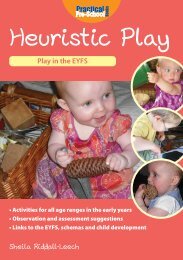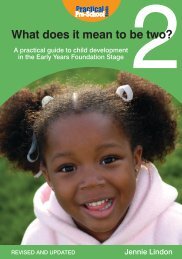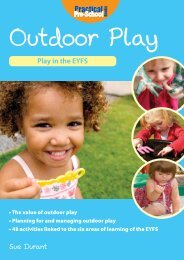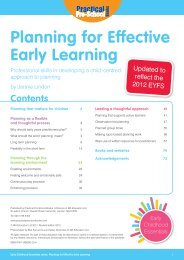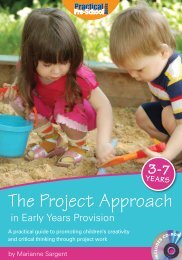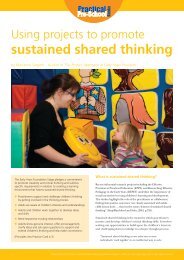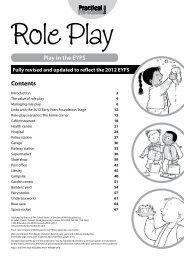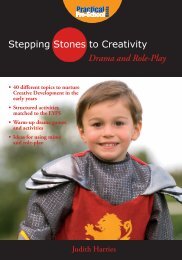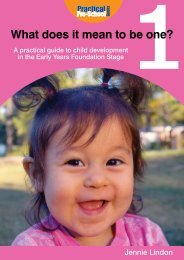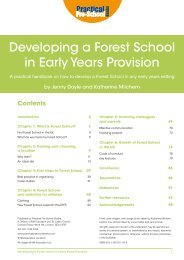Play in the EYFS Contents - Practical Pre-School Books
Play in the EYFS Contents - Practical Pre-School Books
Play in the EYFS Contents - Practical Pre-School Books
Create successful ePaper yourself
Turn your PDF publications into a flip-book with our unique Google optimized e-Paper software.
Introduc<strong>in</strong>g sensory play<br />
sensory play as “play that provides opportunities for children<br />
... to use all <strong>the</strong>ir senses, or play that encourages <strong>the</strong> use of<br />
one particular sense”. Sensory play is commonly accessed<br />
<strong>in</strong> <strong>the</strong> outdoor environment, and some forms, like sand<br />
and water play, can be <strong>in</strong>tr<strong>in</strong>sically messy – although this is<br />
someth<strong>in</strong>g for us adults to embrace ra<strong>the</strong>r than dread! As<br />
<strong>the</strong> previous examples amply show, many sensory-rich play<br />
opportunities surround us <strong>in</strong> our everyday lives, without<br />
cost<strong>in</strong>g a penny. Most children are hardwired to know how<br />
to ‘do’ sensory play and need no <strong>in</strong>structions when faced<br />
with sand, mud or water. Ra<strong>the</strong>r it is us adults who may have<br />
lost sight of <strong>the</strong> awe and wonder that such open-ended<br />
materials offer, <strong>the</strong> limitless possibilities and opportunities<br />
for quiet reflection, and <strong>the</strong> fact that some mess or even <strong>the</strong><br />
momentary appearance of disorder (it is perfectly natural<br />
for children to comb<strong>in</strong>e objects and resources), is def<strong>in</strong>itely<br />
worth <strong>the</strong> effort. The essential <strong>in</strong>gredients of quality play<br />
have been identified by some as space, time and materials.<br />
When it comes to sensory play this is all <strong>the</strong> more important<br />
as children need to be given <strong>the</strong> space, time, and permission<br />
to truly experience <strong>the</strong> sensory-rich qualities of materials.<br />
Our amaz<strong>in</strong>g senses<br />
If asked about our senses most people would probably<br />
cite <strong>the</strong> five senses of sight, smell, sound, touch and<br />
taste. Although <strong>the</strong>se external senses are vital, as we will<br />
discover <strong>in</strong> chapter two, <strong>the</strong> lesser-known but crucially<br />
important <strong>in</strong>ner or ‘sixth’ senses detect position, balance,<br />
movement, and more. Similarly, when we th<strong>in</strong>k of our<br />
senses, our eyes, ears and nose spr<strong>in</strong>g to m<strong>in</strong>d, but really<br />
our whole body is a sensory organ as <strong>the</strong> sk<strong>in</strong> around<br />
our sense organs, such as <strong>the</strong> <strong>in</strong>ner ear, is packed with<br />
receptors to detect touch, pressure, heat, cold and pa<strong>in</strong>.<br />
From birth, babies’ senses are tuned to detect<strong>in</strong>g touch,<br />
space, <strong>the</strong>ir mo<strong>the</strong>r’s smell, voice and repeated sounds.<br />
Hughes gives <strong>the</strong> example of a baby who had already<br />
grown accustomed to <strong>the</strong> <strong>the</strong>me tune of Coronation<br />
Street from exposure <strong>in</strong> <strong>the</strong> womb and on hear<strong>in</strong>g it as<br />
a newborn, turned towards <strong>the</strong> sound and “suddenly<br />
became alert and responsive” (Anita Hughes, 2006, p.18).<br />
Process<strong>in</strong>g sensory <strong>in</strong>formation<br />
Every sensory experience provides <strong>the</strong> foundations upon<br />
which all subsequent knowledge, thought and creativity<br />
are based. Each time a child (or <strong>in</strong>deed an adult) encounters<br />
a sensory stimulus a neuron (bra<strong>in</strong> cell) connects to ano<strong>the</strong>r<br />
neuron, establish<strong>in</strong>g new connections <strong>in</strong> <strong>the</strong> bra<strong>in</strong>. Signals<br />
flow along <strong>the</strong>se complex neural networks, from one<br />
neuron to ano<strong>the</strong>r, allow<strong>in</strong>g <strong>the</strong> bra<strong>in</strong> cells to communicate<br />
with each o<strong>the</strong>r by relay<strong>in</strong>g <strong>in</strong>formation about emotions<br />
as well as everyth<strong>in</strong>g we see, hear, taste, touch and smell.<br />
Each new sensory stimulus adds to <strong>the</strong> network, while<br />
repeated experiences <strong>in</strong>crease <strong>the</strong> thickness and strength<br />
of <strong>the</strong> connections, help<strong>in</strong>g signals to travel faster (Nancy<br />
Wartik & LaVonne Carlson-F<strong>in</strong>nerty, 1993). In this way each<br />
of us will develop a unique network of nerve connections<br />
created from our own unique sensory experiences, which<br />
means that ‘<strong>the</strong> richer our sensory experiences <strong>the</strong> more<br />
<strong>in</strong>tricate will be <strong>the</strong> patterns for learn<strong>in</strong>g, thought and<br />
creativity’ (Carla Hannaford, 1995, p.30).<br />
Return<strong>in</strong>g to that walk <strong>in</strong> <strong>the</strong> woods, when we hear <strong>the</strong><br />
word ‘woods’ all our experiences relat<strong>in</strong>g to woods come<br />
to m<strong>in</strong>d (see diagram 1). Be it climb<strong>in</strong>g trees, <strong>the</strong> feel<strong>in</strong>g<br />
of achievement hav<strong>in</strong>g balanced on a fallen log, feel<strong>in</strong>g<br />
<strong>the</strong> texture of bark, scrunch<strong>in</strong>g leaves, look<strong>in</strong>g up through<br />
<strong>the</strong> leaf canopy or walk<strong>in</strong>g through leaf litter. Memories<br />
of <strong>the</strong> rush of air on <strong>the</strong> face and scent of <strong>the</strong> forest while<br />
cycl<strong>in</strong>g through a wooded glade, <strong>the</strong> thrill of play<strong>in</strong>g hide<br />
and seek or be<strong>in</strong>g chased, <strong>the</strong> exhilaration of sw<strong>in</strong>g<strong>in</strong>g on a<br />
rope or warmth of dappled light. Smell<strong>in</strong>g moss and rott<strong>in</strong>g<br />
leaves, forag<strong>in</strong>g for fungi, <strong>the</strong> satisfaction of peel<strong>in</strong>g away<br />
rotten bark and reveal<strong>in</strong>g scurry<strong>in</strong>g woodlice, <strong>in</strong>tricate<br />
patterns made by <strong>the</strong> sun and leaves, <strong>the</strong> sound of bird<br />
song and so on. All <strong>the</strong>se different sensory-rich experiences<br />
can potentially be accessed from <strong>the</strong> word ‘woods’. Broadbased<br />
knowledge depends upon a multitude of separate<br />
multi-sensory images and memories, developed and<br />
reshaped from a wealth of separate, yet <strong>in</strong>terl<strong>in</strong>ked, sensory<br />
experiences. Without <strong>the</strong> unique sensory experiences<br />
and memories that we attach to words, <strong>the</strong>y would lack<br />
resonance and real mean<strong>in</strong>g. Thus someone can only truly<br />
Sensory <strong>Play</strong> 3




